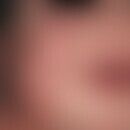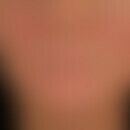Synonym(s)
HistoryThis section has been translated automatically.
de Berker, 1999
DefinitionThis section has been translated automatically.
So far rarely observed and reported, especially on the toenails (big toe), probably traumatically induced, chronic paronychia caused by a disturbance in the growth of one or more nails.
You might also be interested in
EtiopathogenesisThis section has been translated automatically.
Retronychia is caused by continuous or repeated frontal trauma (e.g. due to unsuitable footwear or repeated impact damage to the nail root during sports activities). This type of frontal impact trauma leads to reversible damage to the proximal hyponychium and apparently to a loss of continuity between hyponychium and nail plate. It ultimately leads to arrest of the growth of the still existing nail. The nail root then produces a new nail below the old nail. This newly formed nail, if traumatisation continues to persist, also suffers growth damage that prevents its physiological growth. A nail torso develops underneath the old, already devitalised nail root, with irregular growth that is not strictly forward, but rather upward or backward (hence the somewhat misleading term "retr-onychia" for backward oriented). The consequence is a chronic paronychia with thickened, painful nail root.
ManifestationThis section has been translated automatically.
Female gender preferred.
ClinicThis section has been translated automatically.
Clinically impressive is a chronic, painful proximal paronychia (usually of the big toe nail) with growth retardation or complete growth arrest of the often thickened and discoloured nail.
TherapyThis section has been translated automatically.
It is important to prevent the "Circulus vitiosus" of repeated damage to the nail root and misdirected growth.
Conservative therapeutic measures are not successful in eliminating the chronic inflammatory condition that has already occurred (comparable to an "invisible" unguis incarnatus). In this respect, nail extraction with careful monitoring of an "atraumatic" regeneration process is to be considered the therapy of choice.
LiteratureThis section has been translated automatically.
- Baumgartner M et al (2010) Retronychia: diagnosis and treatment. Dermatol Surgery 36:1610-1614
- de Berker DA et al (2008) Retronychia: proximal ingrowing of the nail plate. J Am Acad Dermatol 58:978-983
- de Berker DA et al (1999) Retronychia-proximal ingrowing nail. J Eur Acad Dermatol Venereol 12: (Suppl 2) 126
- Kim M et al (2015) Great toenail dystrophy: a single-center experience and review of the literature. Korean J Fam Med 36:113-120
- Richert B et al.(2014) Retronychia. Ann Dermatol Venereol 141:799-804
- Piraccini BM et al (2014) Retronychia in children, adolescents, and young adults: a case series. J Am Acad Dermatol 70: 388-390
- Zaraa I et al (2012) Retronychia: a rare cause of chronic paronychia. Dermatol Online J 18:9
Outgoing links (1)
Unguis incarnatus;Disclaimer
Please ask your physician for a reliable diagnosis. This website is only meant as a reference.






